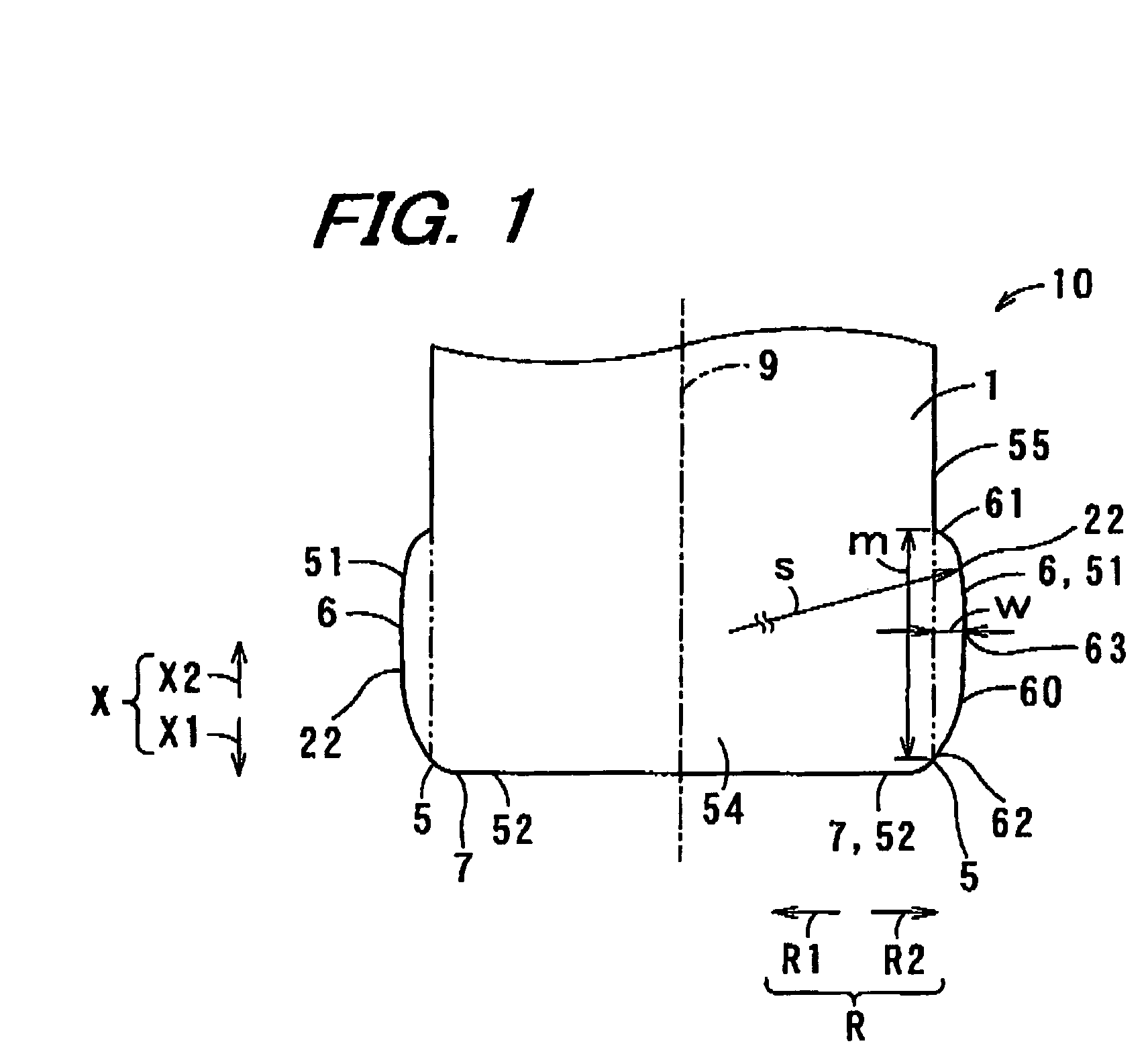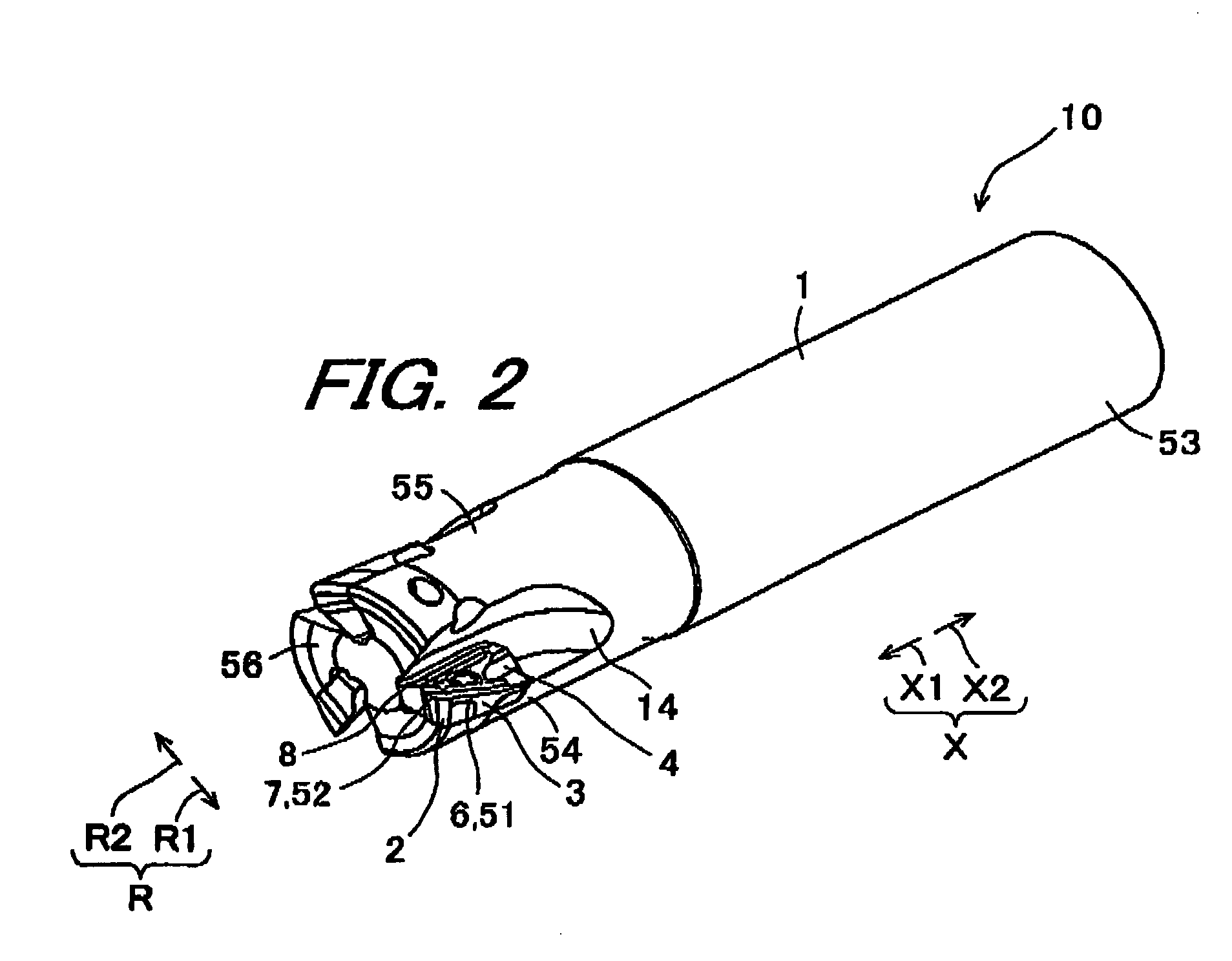Cutting insert and milling tool
a cutting insert and milling tool technology, applied in the field of milling tools, can solve the problems of inability to obtain a machined face with absolutely no steps, inability to manufacture tools, and inability to achieve absolutely no steps, etc., to achieve the sharpness of the milling tool, improve the roughness of the machined surface of the machined wall face, and reduce the cost of machining
- Summary
- Abstract
- Description
- Claims
- Application Information
AI Technical Summary
Benefits of technology
Problems solved by technology
Method used
Image
Examples
first embodiment
[0075]An end mill 10 according to the invention is a substantially cylindrical milling tool that has a main cutting edge 6 at its circumferential periphery and rotates about an axis of rotation 9. While the end mill 10 is rotated about the axis of rotation 9 by a milling machine or the like, the main cutting edge 6 makes contact with a workpiece and discretely cuts the workpiece. Accordingly it is possible to cut the workpiece to a predetermined shape.
[0076]The end mill 10 of this embodiment is made up of a cutting insert (hereinafter abbreviated to insert) 2 on which are formed a long-side cutting edge 51 constituting the main cutting edge 6 and a short-side cutting edge 52 constituting a flat cutting edge 7, and an end mill holder (hereinafter abbreviated to holder) 1 to which the insert 2 is removably fitted. In this embodiment the holder 1 is constructed so that a plurality of for example three inserts 2 can be fitted to it.
[0077]The holder 1 is formed in an approximately cylind...
second embodiment
[0162]In this second embodiment, the sectional shape of the locus of rotation 422 of the main cutting edge 406 slants in the outward holder radial direction R2 with progress in a straight line from a holder axial direction tip end part 462 toward a holder axial direction center part 463, and slants back in the inward holder radial direction R1 with progress in a straight line from the holder axial direction center part 463 toward a holder axial direction base end part 461.
[0163]In this case of the holder axial direction middle part 460 Of the main cutting edge 406 projecting further in the outward holder radial direction R2 than the holder axial direction base end parts 461, 462 also, the same effects as those of the first embodiment can be obtained.
[0164]Besides this the sectional shape of the locus of rotation of the main cutting edge may alternatively follow a gentle curve other than a circular arc, or may extend along a line consisting of a combination of a plurality of straight...
third embodiment
[0166]In the third embodiment, at the location in contact with the workpiece 11, the holder axial direction base end part 561 of the main cutting edge 506 is further inward from the workpiece in the holder radial direction R than the holder axial direction tip end part 562 of the main cutting edge 506.
[0167]In the third embodiment, compared to the rest of the main cutting edge 506, a holder tip end side portion 511 of the holder axial direction middle part 560 of the main cutting edge 506 projects farthest in the outward holder radial direction R2. Consequently, even when the holder 501 bends during cutting, the projection amount by which the holder axial direction base end part 561 of the main cutting edge 506 projects beyond the holder axial direction tip end part 562 of the main cutting edge 506 in the outward holder radial direction R2 can be made small. Therefore, the affect of bending of the holder 1 can be made small, and the machined surface roughness of the machined wall fa...
PUM
| Property | Measurement | Unit |
|---|---|---|
| radius | aaaaa | aaaaa |
| radius | aaaaa | aaaaa |
| distances | aaaaa | aaaaa |
Abstract
Description
Claims
Application Information
 Login to View More
Login to View More - R&D
- Intellectual Property
- Life Sciences
- Materials
- Tech Scout
- Unparalleled Data Quality
- Higher Quality Content
- 60% Fewer Hallucinations
Browse by: Latest US Patents, China's latest patents, Technical Efficacy Thesaurus, Application Domain, Technology Topic, Popular Technical Reports.
© 2025 PatSnap. All rights reserved.Legal|Privacy policy|Modern Slavery Act Transparency Statement|Sitemap|About US| Contact US: help@patsnap.com



